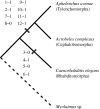Resolving phylogenetic incongruence to articulate homology and phenotypic evolution: a case study from Nematoda
- PMID: 20106846
- PMCID: PMC2871949
- DOI: 10.1098/rspb.2009.2195
Resolving phylogenetic incongruence to articulate homology and phenotypic evolution: a case study from Nematoda
Abstract
Modern morphology-based systematics, including questions of incongruence with molecular data, emphasizes analysis over similarity criteria to assess homology. Yet detailed examination of a few key characters, using new tools and processes such as computerized, three-dimensional ultrastructural reconstruction of cell complexes, can resolve apparent incongruence by re-examining primary homologies. In nematodes of Tylenchomorpha, a parasitic feeding phenotype is thus reconciled with immediate free-living outgroups. Closer inspection of morphology reveals phenotypes congruent with molecular-based phylogeny and points to a new locus of homology in mouthparts. In nematode models, the study of individually homologous cells reveals a conserved modality of evolution among dissimilar feeding apparati adapted to divergent lifestyles. Conservatism of cellular components, consistent with that of other body systems, allows meaningful comparative morphology in difficult groups of microscopic organisms. The advent of phylogenomics is synergistic with morphology in systematics, providing an honest test of homology in the evolution of phenotype.
Figures


References
-
- Albertson D. G., Thomson J. N.1976The pharynx of Caenorhabditis elegans. Phil. Trans. R. Soc. Lond. B 275, 299–325 (doi:10.1098/rstb.1976.0085) - DOI - PubMed
-
- Aleshin V. V., Kedrova O. S., Milyutina I. A., Vladychenskaya N. S., Petrov N. B.1998Relationships among nematodes based on the analysis of 18S rRNA gene sequences: molecular evidence for monophyly of chromadorian and secernentean nematodes. Russ. J. Nematol. 6, 175–184
-
- Andrássy I.1962Über den Mundstachel der Tylenchiden (Nematologische Notizen, 9). Acta. Zool. Hung. 8, 167–315
-
- Andrássy I.1976Evolution as a basis for the systemization of nematodes London, UK: Pitman Publishing
-
- Ashton F. T., Bhopale V. M., Fine A. E., Schad G. A.1995Sensory neuroanatomy of a skin-penetrating nematode parasite: Strongyloides stercoralis. I. Amphidial neurons. J. Comp. Neurol. 357, 281–295 (doi:10.1002/cne.903570208) - DOI - PubMed
Publication types
MeSH terms
LinkOut - more resources
Full Text Sources

